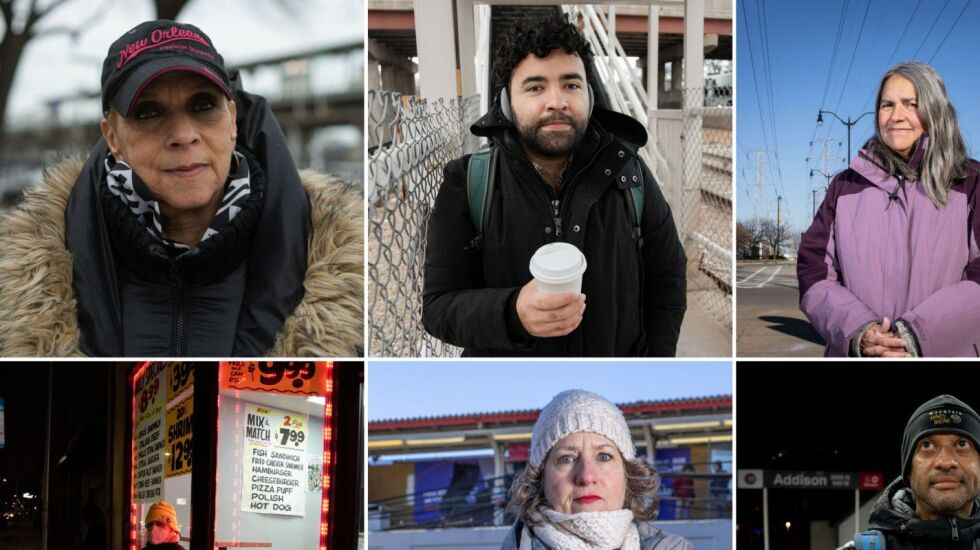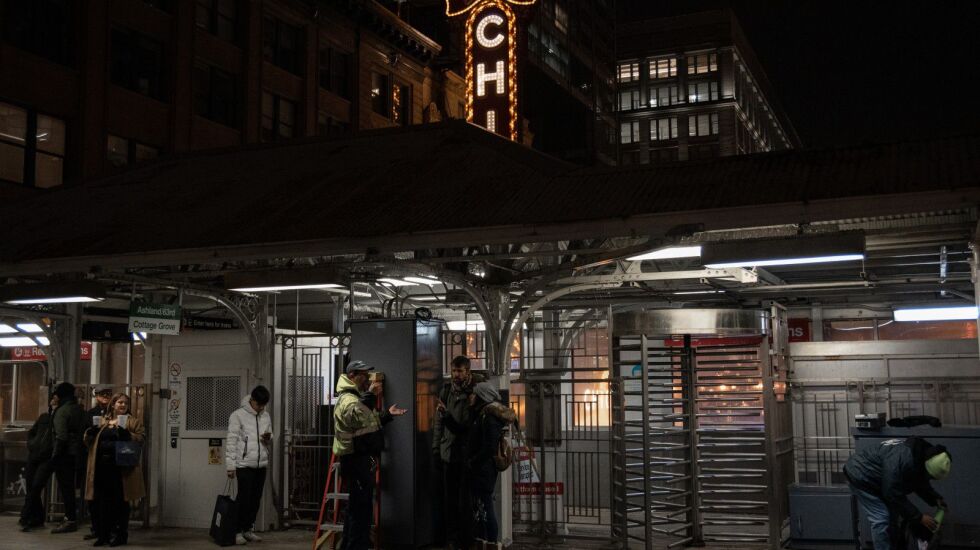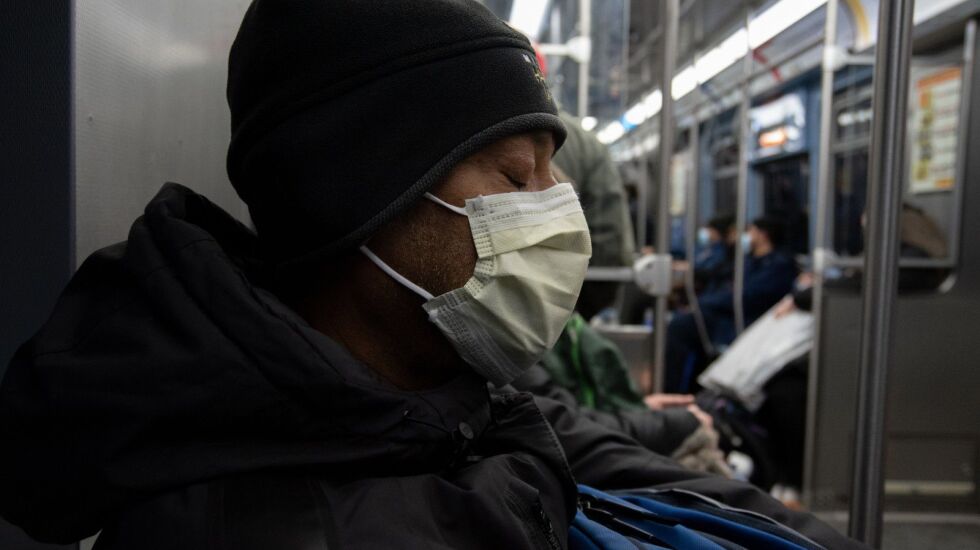
None of that is much solace to John Wilmes, a professor at Roosevelt University who is pursuing a career change so he can work remotely after commuting for 12 years.
“I can’t rely on it anymore,” Wilmes said of the CTA. “I’ve always been a defender of the Chicago Transit Authority. I’ve always said, ‘Actually, it’s not that bad. It’s actually one of the good things about living here. It’s pretty reliable.’ That’s no longer true. And the city doesn’t seem to care.”
Ladell Johnson, who works in security for a school near Michigan Avenue, said scheduled buses sometimes don’t arrive and that the CTA doesn’t fairly serve her South Side neighborhood.

In contrast, Johnson said, “When you’re downtown, and you’re trying to come home, you have a bunch of buses going to the North Side passing by that are empty.”
Also, she said, early morning buses are unreliable and don’t align with the agency’s trackers that count down wait times for riders.
Wilmes and Johnson are among nearly 2,000 people who responded to a WBEZ survey of CTA riders distributed in November via email, text, social media and outreach through community groups. The aim — as the agency embarks on an improvement plan regarding wait times and safety issues and chronic staffing gaps — was to gauge riders’ experiences and attitudes.
The majority of those responding vented about delays, “ghost” buses and safety.
But there also was a good degree of gratitude toward and empathy for CTA workers.

Many extolled the virtues of a strong public transit system as part of the city’s DNA despite their frustrations. And they wanted more transparency and more accountability from the CTA.
Riders were encouraged to submit questions for the agency.
Dorval Carter, the CTA’s president, declined interview requests about the results. But Brian Steele, the agency’s vice president of communications, participated in a wide-ranging interview covering riders’ questions on everything from inaccurate trackers to safety improvements.
Long waits, ghost buses, poor tracking
Nearly nine of 10 survey-takers — 89% — said they’d experienced a service delay in the past 30 days.
A student said she’d been late for school 13 times due to delays on the No. 82 Kimball-Homan bus. Elderly riders described missed appointments because buses and L trains were delayed to the University of Illinois Hospital campus. A manager said his commuting employees were consistently late to arrive for their hourly job, affecting business.
“I have been riding the CTA trains for most of my adult life, even during the pandemic since I am an essential worker, so it makes me very sad to see the conditions on the train now,” said Mary Ann Schmelzer, a nurse who commutes on the Yellow Line/Skokie Swift a few days a week.

Some riders said they’re spending more now on rideshare apps. A few cited difficulties with the CTA as a reason for switching to remote jobs. Some riders said they were bailing on the CTA entirely.
Many survey-takers said service has gotten worse since the coronavirus pandemic began.
“I interact with the CTA nearly every day, especially in the winter months,” rider Alekzander Sayers said. “I enjoy riding the bus, but I just don’t have faith in it when I’m in a crunch.”
He, like hundreds of others, said he’s frustrated by ghost buses that show up on a tracker or schedule but don’t actually appear and even more so by the lack of communication about them.
“I feel like people wouldn’t be mad if the wait times were long but accurate,” Sayers said. “At least, you know and can plan. It gets frustrating when you wait for something that never shows.”

A common complaint was about a poorly functioning tracker system. Riders asked when promised technology upgrades to address the problem — part of the agency’s ”Meeting the Moment” improvement plan — would be deployed.
“I have waited well over an hour for buses that don’t show up,” rider Elise Auerbach said. “I have been late for work so often, and it is impossible to plan on being on time. Of course, the bus tracker has no relation to reality whatsoever. I wait for either the 2 or 6 at State and Lake and very often see eight to 10 146 and 148 buses come by, mostly empty, before a 2 or 6 finally arrives. It is so frustrating. Can’t they track the ridership?”
Respondents had other specific complaints about bus service, Among them:
- There don’t appear to be as many buses as there were before the pandemic. So, when a bus does arrive, it’s more crowded. Some also said the agency needs to deploy longer buses on popular routes, such as the Jackson Park Express No. 6 bus.
- Crowded buses sometimes don’t stop, driving past people waiting for a bus.
- Drivers’ shift changes in the middle of a route have left riders stranded on a bus after drivers abruptly stopped the bus and left. “The relief driver isn’t there, and the original driver just leaves,” said Natasha Leyk, who commutes mostly on the No. 147 bus. “When you have the Clark bus blocking traffic at Foster and Clark because of the narrow road and no driver changeover — that gets awkward. Or a bus full of people waiting on a driver that then gets passed by another bus on the route — it ends up being frustrating for riders.”
- Delayed buses are sometimes followed by two or three showing up in a row — bus-bunching.
- Bus-to-train schedules don’t line up, causing riders who depend on a combination of buses and trains to exit one mode of transportation, only to find they’ve missd a transfer.

Safety, harassment
A wave of violent incidents on the Red Line last year rattled riders. Some said they no longer feel safe taking public transportation outside of the busiest morning and evening commute periods.
Slightly under half of riders (45%) who took the survey said they feel “somewhat unsafe” or “very unsafe” riding a bus or train. About the same number (47%) said they feel “fairly safe.” Seven percent said they have felt “very safe” riding a bus or train in the past 30 days.
“As a woman, I do not feel safe taking the train or the bus at times,” said Joy Miles, who takes the Red Line from Edgewater to East Lake View. “I’ve been felt up. I’ve had someone try to get into my backpack while I’m holding onto it. I’ve been shoved. I’ve been pushed.”
Another Red Line rider, Sean Macleish, said he was on the way home from work one day when a woman selling alcohol on the train pulled out a meat cleaver and said she was going to cut him. Macleish said a man grabbed it from her hand. Another time, he said he saw a woman kick a man in the neck.
“I take the Red Line almost every day for work, and there’s always this anxious feeling like, ‘What’s going to happen today?’ ” he said. “I’ve seen people being harassed, assaulted, I’ve seen people doing drugs and defecating on the train. It seems to have only gotten worse since the pandemic.”
The CTA has pledged to boost security, and the number of “security checks” conducted by police and security are an item on the agency’s new tracker. But many riders said they see security personnel on train platforms but not on trains or buses.
“No one fears any repercussions of smoking, drinking or even defecating on the CTA,” said Paul Rettig, who rides a few times a week. “And if you say anything, you could get assaulted. Someone tried to pickpocket me in the Loop on the Blue Line two months ago. This is the face of our city to visitors.”

Cigarettes, weed, stink
Smoking was one of the most common frustrations among L and subway riders, after delays and safety.
Smoking and electronic cigarettes are outlawed by the CTA, which says police officers issued more than 1,000 citations for smoking in recent months. But riders said they aren’t seeing the no-smoking rules enforced. And several said they feel uncomfortable saying anything to smokers because they fear harassment.
“I’m a younger teacher, and I worry about how I’m perceived walking into class drenched in weed smoke,” said an architecture professor who asked to be identified only by his first name, Michael.
He said he’s a daily rider and that, while the marijuana smoke isn’t enough to make him stop taking the train, it makes the commute less comfortable. He and others said they would not feel safe asking smokers to stop.
Kristin Lynch said she has severe asthma and switched to driving after she rode a train, and someone started smoking. She switched cars, but someone in the new car was smoking, too, so she was surrounded by smoke for about 20 minutes, and it caused her asthma to flare up.
“I ended up having to go home,” Lynch said. “I used my breathing treatment and was on steroids for 10 days after that.”

Dirty trains, stations
Feces at the Austin station of the Blue Line. A perpetually dirty North/Clybourn stop on the Red Line. Missing garbage cans at station entrances. People peeing on platforms. Dirty bus seats and garbage strewn down aisles.
These were among other complaints heard from riders, who said the CTA has a lot of cleaning up to do.
The CTA has said increasing janitorial staffing is a key aim in the coming months, in addition to its regular cleanings of buses, trains and stations.
Yet more than 40 riders mentioned the words “urine,” “feces” or “defecation” in their responses.
“It’s gross, it’s dirty, the platform” — at the Red Line Grand stop — “is just like a bathroom down there,” said Emily Vasiliou, who takes the L to work a couple times a week. “It just stinks.”
Raunel Urquiza agreed.
“There aren’t public restrooms, so people use the bathroom in plain sight,” said Urquiza, who takes the CTA daily.
Urquiza, Vasiliou and others said they’ve taken the CTA for years and have noticed a significant decline in cleanliness and behavior enforcement. People playing loud music, harassing passengers, selling drugs, smoking cigarettes and marijuana, leaving feces on the trains and generally causing mayhem were common complaints.
The survey found a general perception that there has been a marked increase in the number of homeless riders sleeping on trains. Riders acknowledged that is a problem the agency can’t contend with on its own. Some said they want the city to establish an approach that would include more services and social agency involvement.

Elevator breakdowns, accessibility
Broken elevators and escalators at train stations came up as a complaint from parents, older riders and people with disabilities.
On bus lines, riders flagged lack of benches, bus stations without roofs or awnings to duck away from bad weather and heaters that barely work.
“Handicapped accessibility is so frustrating,” said Amanda Zrust, who commutes from the Howard L station to the Loop. “Sometimes, the elevator is down, and not every L station even has one. It’s not great that public transportation is only ‘public’ for able-bodied residents.”
“There is nowhere for a disabled person to sit down to wait,” said Leona Lee, another rider. “Arthritis makes it very painful for me to stand for long. So I am stuck at home often. I’d take the CTA much more often if I could sit to wait for a bus.”
Some riders expressed concerns that the CTA doesn’t appear to be accountable to the public. They want more communication from CTA leadership and wondered what concrete plans are in place to improve reliability and cleanliness.
Contributing: Samantha Callender, Courtney Kueppers







